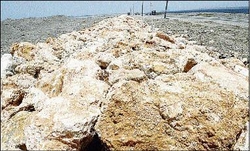
These rocks form the dune being created by the National Works Agency along the Palisadoes strip in Kingston. - photos by Norman Grindley/Chief Photographer
The Palisadoes road in Kingston on a sunny afternoon in May is a perfect scene of peace and tranquillity. Vendors along the strip relax in the shade of the coconut trees as the cool breeze caresses their cheeks. On the seaside south of the strip, waves, no taller than a few inches, playfully splash against the two-metre-high dunes erected by the National Works Agency (NWA) to stave off high tides.
But all this is in complete contrast to the havoc, which is often created by hurricane-force tides as water floods the strip, damaging the road and tossing tons of sand and other debris on to the roadway.
The Palisadoes main road is the only access route to the Norman Manley International Airport and the town of Port Royal.
For the past several hurricane seasons, the peninsula, which is considered one of Jamaica's vital pieces of infrastructure, has been made impassable by high waters and debris, preventing tourists and other travellers from leaving the island. This was the case in 2004 when Hurricane Ivan's storm surges deposited huge mounds of sand and stones on to the road, blocking it for two days.
Protection system
During his contribution to the 2008 Sectoral Debate, Transport and Works Minister Mike Henry announced that the NWA was in the process of building a stretch of two-metre-high dunes with funds, amounting to some US$10.8 million, acquired from the Caribbean Development Bank. This, however, would only protect the roadway from a Category Two hurricane. Henry, however, said the long-term plan for the Palisadoes was to apply the Cuban-style rock revetment-protection system along the 12-kilometre strip. The dunes would also be raised to 4.1 metres to adequately protect the area from storm surges caused by a Category Five hurricane.
Last week, Patrick Wong, chief executive officer (CEO) of the NWA, told The Gleaner that the first phase of the emergency works on the peninsula was almost complete, with the second phase expected to begin sometime later this year.
However, with forecasters predicting a slightly active 2009 season, with some chance of one to three major hurricanes, the Palisadoes peninsula could again be under severe threat.
"We haven't been hit by a Category Five hurricane for some time, but what is there now will give us some measure of relief," the NWA CEO reasoned.
Grossly inadequate
However, vendors working along the strip believe the two-metre wall now erected is grossly inadequate to protect the roadway from even the simplest of showers.
"Even just the other day a little rain fall and water flood the road, not even a bike man couldn't pass," said coconut vendor Anthony Davis, who has been selling along the strip for a number of years.
Wong said the NWA was finalising the design and funding for stage two of the work, which is expected to take a period of 18 months to complete. He also said part of the plan would include the lifting of the Palisadoes road - which is at present below sea level - from the Harbour View roundabout to Gunboat Beach.
However, Wong could not provide exact details on how much the project would cost or where the funds would come from.
"It is being treated with the urgency that is required. We are on a fast track where this is concerned, so once the financing has been concluded and the procurement of the contract has taken place, we are hoping to start the assignment," he said.
athaliah.reynolds@gleanerjm.com